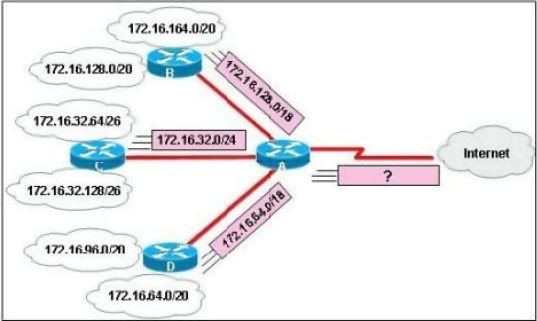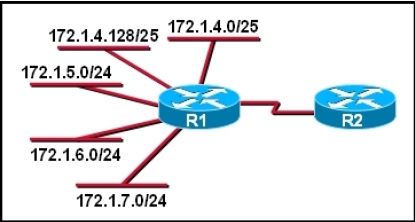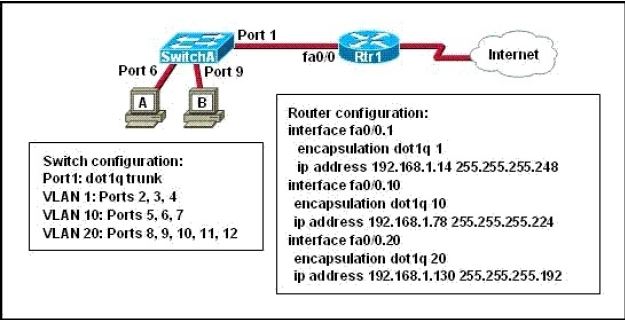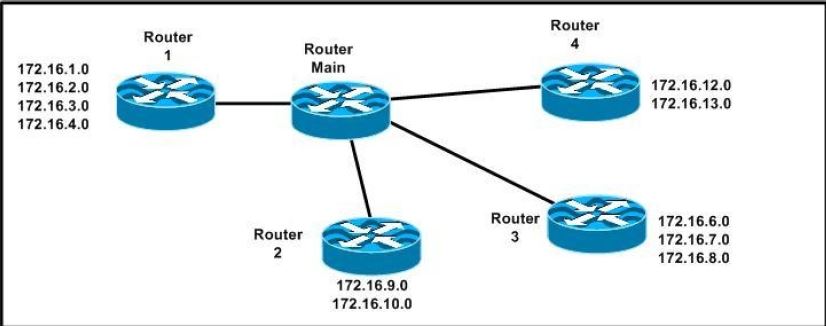Refer to the exhibit.

In this VLSM addressing scheme, what summary address would be sent from router A?
A. 172.16.0.0 /16
B. 172.16.0.0 /20
C. 172.16.0.0 /24
D. 172.32.0.0 /16
E. 172.32.0.0 /17
F. 172.64.0.0 /16
Refer to the exhibit.

In this VLSM addressing scheme, what summary address would be sent from router A?
A. 172.16.0.0 /16
B. 172.16.0.0 /20
C. 172.16.0.0 /24
D. 172.32.0.0 /16
E. 172.32.0.0 /17
F. 172.64.0.0 /16
How is an EUI-64 format interface ID created from a 48-bit MAC address?
A. by appending 0xFF to the MAC address
B. by prefixing the MAC address with 0xFFEE
C. by prefixing the MAC address with 0xFF and appending 0xFF to it
D. by inserting 0xFFFE between the upper three bytes and the lower three bytes of the MAC address
E. by prefixing the MAC address with 0xF and inserting 0xF after each of its first three bytes
Refer to the exhibit.

What is the most efficient summarization that R1 can use to advertise its networks to R2?
A.
172.1.0.0/22
B.
172.1.0.0/21
C.
172.1.4.0/22
D.
172.1.4.0/24
172.1.5.0/24
172.1.6.0/24
172.1.7.0/24
E.
172.1.4.0/25
172.1.4.128/25
172.1.5.0/24
172.1.6.0/24
172.1.7.0/24
Which option is a valid IPv6 address?
A. 2001:0000:130F::099a::12a
B. 2002:7654:A1AD:61:81AF:CCC1
C. FEC0:ABCD:WXYZ:0067::2A4
D. 2004:1:25A4:886F::1
Which three are characteristics of an IPv6 anycast address? (Choose three.)
A. one-to-many communication model
B. one-to-nearest communication model
C. any-to-many communication model
D. a unique IPv6 address for each device in the group
E. the same address for multiple devices in the group
F. delivery of packets to the group interface that is closest to the sending device
A national retail chain needs to design an IP addressing scheme to support a nationwide network. The company needs a minimum of 300 sub-networks and a maximum of 50 host addresses per subnet. Working with only one Class B address, which of the following subnet masks will support an appropriate addressing scheme? (Choose two.)
A. 255.255.255.0
B. 255.255.255.128
C. 255.255.252.0
D. 255.255.255.224
E. 255.255.255.192
F. 255.255.248.0
Refer to the exhibit.

A network administrator is adding two new hosts to SwitchA. Which three values could be used for the configuration of these hosts? (Choose three.)
A. host A IP address: 192.168.1.79
B. host A IP address: 192.168.1.64
C. host A default gateway: 192.168.1.78
D. host B IP address: 192.168.1.128
E. host B default gateway: 192.168.1.129
F. host B IP address: 192.168.1.190
Which IPv6 address is the all-router multicast group?
A. FF02::1
B. FF02::2
C. FF02::3
D. FF02::4
Refer to the exhibit.

Which address range efficiently summarizes the routing table of the addresses for router Main?
A. 172.16.0.0./21
B. 172.16.0.0./20
C. 172.16.0.0./16
D. 172.16.0.0/18
Which IPv6 address is valid?
A. 2001:0db8:0000:130F:0000:0000:08GC:140B
B. 2001:0db8:0:130H::87C:140B
C. 2031::130F::9C0:876A:130B
D. 2031:0:130F::9C0:876A:130B